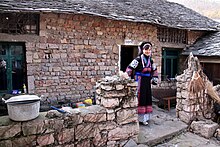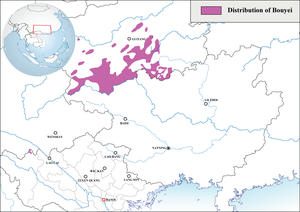
Back Ureuëng Buyei ACE شعب البوي Arabic Builər Azerbaijani པུའུ་དབྱི་མི། Tibetan Buó-ĭ-cŭk CDO Puejové Czech Bouyei Danish Bouyei (Volk) German Bujioj Esperanto Buyei Spanish
 A Bouyei woman in front of her house in China | |
| Regions with significant populations | |
|---|---|
| Languages | |
| Bouyei • Mandarin Chinese | |
| Religion | |
| Shigongism • Buddhism | |
| Related ethnic groups | |
| Zhuang |
| Bouyei people | |||||||||||||||||||
|---|---|---|---|---|---|---|---|---|---|---|---|---|---|---|---|---|---|---|---|
| Chinese name | |||||||||||||||||||
| Simplified Chinese | 布依族 | ||||||||||||||||||
| Traditional Chinese | 布依族 | ||||||||||||||||||
| |||||||||||||||||||
| Vietnamese name | |||||||||||||||||||
| Vietnamese alphabet | người Bố Y | ||||||||||||||||||
| Bouyei name | |||||||||||||||||||
| Bouyei | Buxqyaix | ||||||||||||||||||


The Bouyei (also spelled Puyi, Buyei and Buyi; self called: Buxqyaix, [puʔjai] or "Puzhong", "Burao", "Puman"; Chinese: 布依族; pinyin: Bùyīzú; Vietnamese: người Bố Y), otherwise known as the Zhongjia, are an ethnic group living in Southern Mainland China. Numbering 3.5 million, they are the 10th largest of the 56 ethnic groups officially recognized by the People's Republic of China.
The Bouyei primarily live in the Qianxinan and Qiannan prefectures of southern Guizhou Province, as well as in Yunnan and Sichuan provinces and the Guangxi Zhuang Autonomous Region.[4]
Some 3,000 Bouyei also live in Northern Vietnam, where they are one of that nation's 54 officially recognized ethnic groups. In Vietnam, they are located in Mường Khương District of Lào Cai and Quản Bạ District of Hà Giang Province.
- ^ "Main Data of the Seventh National Population Census". Stats.gov.cn. Archived from the original on 11 May 2021. Retrieved 25 July 2021.
- ^ "China Statistical Yearbook 2021". Archived from the original on 12 November 2021. Retrieved 12 November 2021.
- ^ "Report on Results of the 2019 Census". General Statistics Office of Vietnam. Retrieved 1 May 2020.
- ^ Davis, Edward Lawrence (2005). Encyclopedia of Contemporary Chinese Cultures. Routledge. p. 65. ISBN 9780415777162.